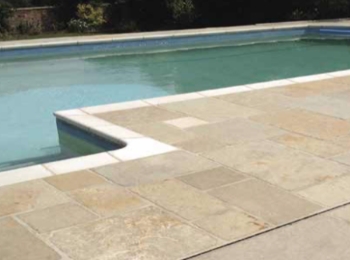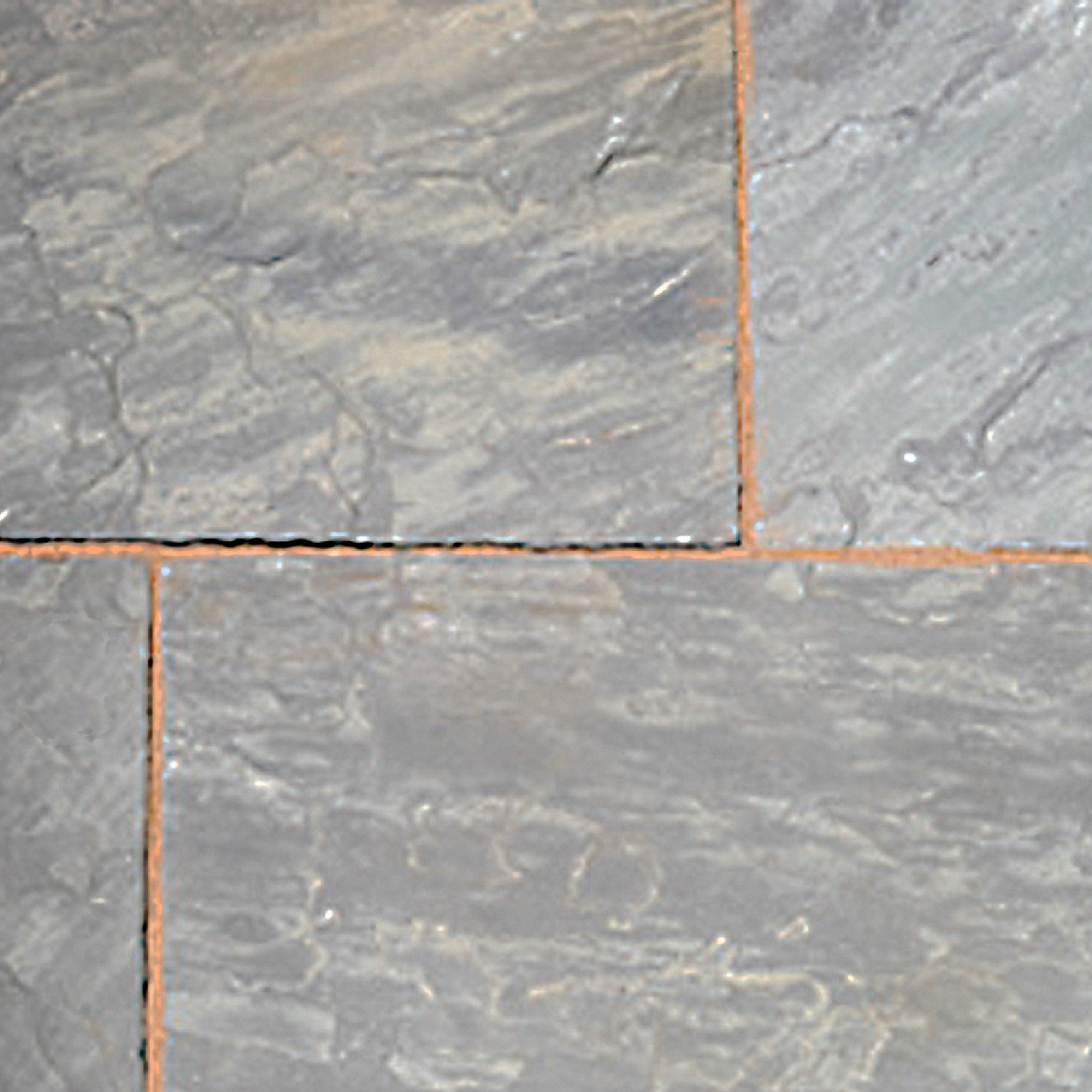-
Patio Pavers
By Material By Surface FinishThere are many types of natural stone available, so it is important to choose the right natural stone for you. Natural Paving's stone has been tested by a lab in the US and has far surpassed all ASTM requirements for paver material. Find out more...Tests include:
SI (Compressive Strength ASTM C140-15). The is the amount of pressure per square inch that may be applied before the stone breaks
Absorption Rate (ASTM C140-15). A low absorption rate is crucial to prevent stone holding onto water, especially in colder climates where high water content can result in the stone cracking
Coefficient of Friction Rate (ASTM C140-15). This is the slip resistance rating o the stone to ensure if is safe for use outside
Furthermore, all products from Natural Paving are CE marked to ensure they meet with strict EU regulations that were introduced in 2013. European standards EN1341 (flagstones), EN1342 (pavers) and EN1343 (kerbs) specify the requirements and test methods for each of these. The CE testing covers areas similar to ASTM including water absorbency, flexural strength and frost resistance.
All natural stone products have been tested to show the various properties of each stone and how it is likely to react under different circumstances.
-
Explore the Collections
Classicstone™ Collection
-
Golden Fossil Natural sandstone with a light color blend of cream, buff, pink and gray with occasional fossil imprints
-
Harvest Natural sandstone with a warm blend of brown, camel and cooler gray contrasting tones
-
Promenade Natural sandstone in mainly light gray color tones with subtle mix of darker shades with occasional buff banding
-
Lakeland Natural sandstone with a selection of cool, understated tones of brown, khaki, lilac and gray
-
Graphite Natural sandstone with a selection of dark, charcoal gray tones accompanied by brown and buff swathes
-
Charcoal Natural limestone in a rich dark matt gray that gradually lightens in sunlight to a mix of mid-gray tones
-
Steel Blue Natural limestone in a cool blue-gray color mix with occasional copper banding
De Terra™ Collection-
Harvest Path and driveway pavers in natural sandstone with a warm blend of brown, camel and cooler gray contrasting tones
-
Promenade Path and driveway pavers in natural sandstone in mainly light gray color tones with subtle mix of darker shades with occasional buff banding.
-
Lakeland Path and driveway pavers in natural sandstone with a selection of cool, understated tones of brown, khaki, lilac and gray.
-
Charcoal Driveway pavers in natural limestone in a rich dark matt gray that gradually lightens in sunlight to a mix of mid-gray tones.
-
Sahara Pathway pavers in natural limestone in buttermilk and matt gray shades with occasional burnt copper tones.
-
- Driveway Pavers
- Wall Blocks
- Pool Coping & Steps
- Features
- Inspiration Center Get Ideas and shop the look
- Sale
You have no items in your shopping cart.
Cleaning, aftercare and characteristics of natural stone
Cleaning
Regular maintenance and cleaning of your new natural stone area is recommended to keep the area looking its best. There are various cleaners available on the market. Some cleaners specialise in dealing with specific types of stains, and others are general cleaners.
We recommend you brush your paved area regularly as well as cleaning it from time to time. Ensure you use a soft bristled brush when sweeping your paved area, as tougher wire brushes could scratch the stone.
Brushing the stone will provide the safest option for keeping the stone clean, using water with a neutral pH soap or detergent should be sufficient for routine maintenance. Power washers may be too powerful and cause damage to the surface of the stone and the mortar joints. If they are used do so with great care and at your own risk.
Strongly acidic or alkaline cleaners may also cause severe damage to the stone and create other environmental problems.
Always check the instructions on the product before using it to clean your natural stone.
Before using any cleaning products on your natural stone test a small, discreet area of paving first to make sure you are happy with the result.
Sealing
There are many sealers available on the market that offer different finishes. Natural stone does not have to be sealed and so sealing is a personal choice. Some sealers are designed to affect the appearance of the stone, such as leaving a satin or invisible finish. Sealing can help delay the absorption of liquids also.
An important factor to consider if deciding to seal your stone is whether or not the sealer is breathable because if it is not then mobile salts in solution can be trapped beneath the surface. An example of a potential problem caused by the use of the wrong sealer would be where efflorescence develops but the sealer prevents salts from exiting through the sealed surface. The build-up of the salts not only can result in a difficult to remove stain but can often cause disruption and breakdown of the surface itself.
With unbreathable sealants, it is normally recommend that you wait three months before sealing your recently paved area, to allow for efflorescence to appear. This can then be washed off before sealing.
If using a breathable sealant, the paved area can usually be sealed straight after installation, but always check with the product manufacturer.
If you make the decision to use a sealer on your natural stone, test the product on a small, discreet area first, to make sure you are happy with the result.
Characteristics of Natural Stone
Different environmental conditions can result in circumstances that lead to a change in the appearance of natural stone; this may sometimes be a stain or surface discoloration. Depending upon the type of stone and discoloration or stain that appears there are potential solutions.
Green Staining
Appearance & Causes- Caused by shaded areas on the paving which cannot dry.
- Poorly drained areas where water can sit.
- Damp areas which moss and algae can thrive.
- Extract from fallen leaves which have been left in place.
- Staining is usually green in colour, has also been known to be yellow and black.
- Regularly sweep your paved area to avoid any growths from taking hold. Only use soft bristled brushes on natural stone, as wire brushes will scratch the surface.
- Regularly maintain overhanging shrubbery to allow sunlight and air onto the paved area.
- Once staining has occurred, there are specialist and general cleaners on the market which can tackle this type of problem
- NEVER use acid wash on natural stone
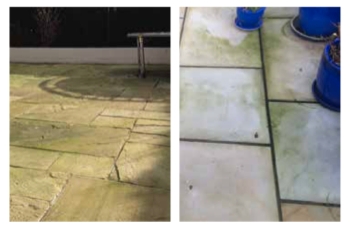
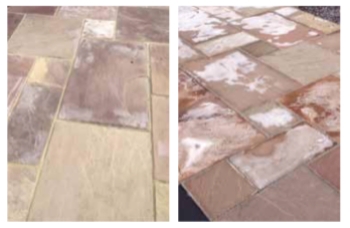
Efflorescence
Appearance & Causes- Typically a naturally occurring phenomenon where salt from the bedding materials migrates up through the stone and appears on the surface.
- Will leave white marks on the surface of your stone.
- Typically occurring shortly after laying, this cannot be prevented as this is a natural occurrence.
- It may wash away over time with weathering.
- Specialist and general cleaners are on the market which are known to tackle this issue.
- Check the data sheet for compatibility with your stone and carry out a trial area first.
- NEVER use acid wash on natural stone
Black Staining
Appearance & Causes- Caused by colonies of black lichen on the stone.
- The lichen will feed off the minerals in your natural stone, eventually burying themselves further down into the stone over time, making them difficult to remove.
- Can appear as black spots or as larger black stains.
- Regularly sweep your paved area to avoid growths from taking hold. Only use soft bristled brushes on natural stone, as wire brushes will scratch the surface.
- Once staining has occurred, there are specialist and general cleaners on the market which can tackle this type of staining.
- Check the data sheet for compatibility with your stone and carry out a trial area first.
- NEVER use acid wash on natural stone
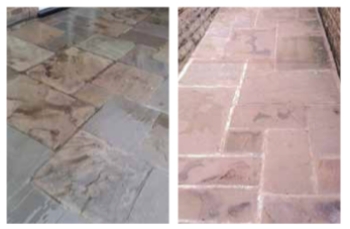
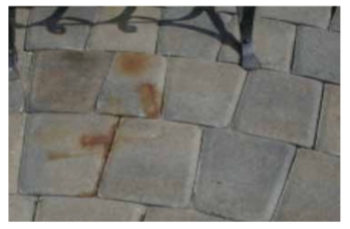
Iron Imperfections
Appearance & Causes- Orange staining can appear on a stone where Iron is present. This can be from within the stone itself, or from an external source.
- Some stones contain iron naturally, and stone can weather over time to reveal these orange markings.
- There is a threat of orange staining when using weed killers and fertilisation products near your natural stone. Take extra care when using these sorts of chemicals around natural stone.
- Staining can also occur from metal structures left on the stone. When the metal reacts with water, it will begin to rust and leave a stain on the stone.
- There are cleaners available on the market which have been known to resolve this type of staining in some cases.
- Check the data sheet for compatibility with your stone and carry out a trial area first.
- Take extra care when using fertiliser around natural stone. Even once the chemicals have been sprayed, the rain can wash them onto your natural stone which can result in staining.
- Do not leave any metal garden furniture or sculptures on your natural stone for long periods of time. Regularly move the furniture and clean the paved area.
- NEVER use acid wash on natural stone
Through Bed Staining
Appearance & Causes- This staining is the result of water soaking through the stone and reaching the mortar bed, making it wet again.
- Results in ‘damp’ looking patches on the surface of the stone.
- This is more likely to occur if the flagstones have not been installed on a full mortar bed.
- When installing natural stone, lay on a full mortar bed.
- This will not prevent through bed staining, but will reduce
- The chances the of it taking place. All good practice guidance suggests that paving should be fully bedded and not laid on dots and dabs.
- On light coloured stones use lighter coloured sand and cement.
- Consider using a bonding slurry
- Try a test piece before undertaking full project.
- NEVER use acid wash on natural stone
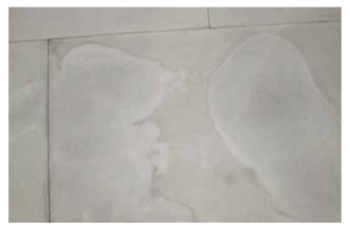
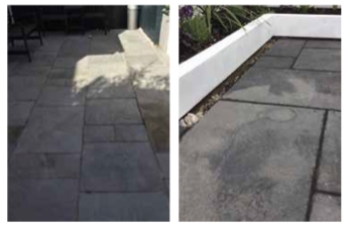
Weathering
Appearance & Causes- Weathering is something that cannot be prevented. As the stone is exposed to the elements, over time it will weather and it can change in appearance.
- The stone can be expected to change in colour slightly. For example, some of our Grey stones have been known to reveal some brown/orange hues after weathering.
- Some products may fade with weathering, especially in sunnier climates. Black stones have been known to weather to a dark grey colour.
- Weathering cannot be prevented.
- Sealers are available on the market which can help the stone retain it’s colour, preventing or delaying the fading process.
- The sealer will need to be re-applied regularly as part of a planned maintenance regime.
- Products are also available on the market which can restore faded colours already lost to weathering.
- NEVER use acid wash on natural stone
Delamination
Appearance & Causes- Delamination is typically water and temperature related and can be linked to a number of causes including moisture sensitive minerals aligned with the natural bedding or cleavage in a rock. This is usually more evident in slate which often has a repetitive thin layering but can be seen in some sandstones.
- The surface of the stone can flake away, exposing the next layer of stone underneath, leaving chips of stone loose on the paving.
- As this is a natural occurrence, it cannot be predicted or prevented.
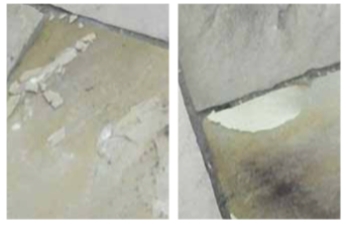
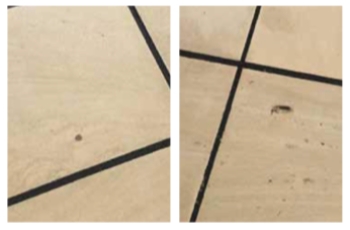
Surface Imperfections
Appearance & Causes- These can appear in the form of small brown marks or pits on the surface of the stone.
- Can often be the result of small mud lenses naturally present at the surface of the stone.
- Weathering of the mud lens can result in the development of a small hole or pit.
- Some sections of stone may never reveal an imperfection, whilst others can weather and reveal themselves after days, month’s or years.
- Natural stone varies in it’s makeup, it cannot be predicted what is within every piece of stone and how it will react to weathering.
- Should an imperfection weather on the surface and leave a hole, there are specialist fillers on the market to resolve this issue.
Salt Damage
Appearance & Causes- When in contact with stone, water containing salts may penetrate deep into it, eventually evaporating and leaving behind salt crystals. These crystals continue to grow within the stones structure.
- Over time the crystal growth will cause expansive forces that can result in the breakdown of the structure of the stone, often causing cracks and chipping on the surface of the stone.
- The stone surrounding the pool will become chipped, and weathered in appearance.
- Take expert advise on the pool system used to prevent this issue.
